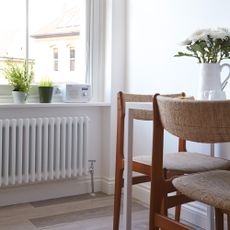How to care for houseplants over winter – 6 ways to keep them alive and thriving during the colder months
The experts share their top advice


Even though they are kept indoors, houseplants can still be affected by the cold winter months. Drastic changes in temperature, including some periods around or below freezing and a lack of sunlight, can have a real impact on how to care for houseplants over winter and whether or not they will make it until spring.
‘In a time when we are spending most of our day indoors, it is more important than ever to bring these small touches of nature indoors,’ says Dani Turner, customer experience director at Bunches. However, many houseplants ‘are normally from tropical and warm temperate regions where they don’t experience the same winter temperatures as we do in the UK,’ Hayes Garden World's gardening expert, Angela Slater, explains. Because of this, they’re not used to the colder and darker conditions.
And ‘when exposed to the cold, houseplants may turn yellow, white or brown and leaves could curl and drop,’ Chris Bonnett, founder of GardeningExpress, warns.
But there are some things that we can do to prevent any damage to our beloved houseplant ideas over the winter months.
How to care for houseplants over winter
‘As the seasons change, so should the way you look after your houseplants,’ suggests Samantha Richards, garden gazebo expert at Gazeboshop. And we certainly agree.
Here are 6 of the easiest ways to set your houseplants up for success over the winter months.
1. Keep them in a stable, warm environment

Stability is key for houseplants during the winter months and this is especially true when it comes to the temperature. ‘Most houseplants grow well in regular room temperature, but they don’t like temperature extremes or frequent fluctuations. So, make sure to keep them away from open windows and doors to shield them from cold draughts,’ says Fiona Jenkins, MyJobQuote.co.uk’s gardening and plant expert.
‘Equally, place your plants away from heat sources such as radiators or fireplaces which are used more often during winter.’ This also means moving houseplants from particularly cold rooms in your home. While your plants may flourish being kept in a conservatory over the warmer months, temperatures can easily dip below zero overnight in this space.
‘Anywhere from 12-20 degrees is usually sufficient for house plants to keep thriving in winter, so don't worry about having to really heat up your home for them,’ Steve Chilton, garden expert at LeisureBench explains. Bloom&Wild's plant expert, Keira Kay agrees, 'make sure the room you keep them in is between 12-18°C.'
Chris also has a top tip: ‘Wrap your plants in bubble wrap to help them contain as much heat as possible. This is an affordable and common way for plant lovers to prevent heat loss in the colder months.' Keep a small bubble wrap roll from Amazon handy so you can grab it when you need it.
2. Increase the humidity
As we cosy up in the winter, 'indoor heating tends to dry out the air, which can be detrimental to many houseplants,' Georgina O'Grady, Managing Director at Evergreen Direct, cautions.
‘While 30-60% is a good range of indoor humidity for comfort and health, tropical plants especially will prefer the higher end of that spectrum,’ Fiona warns. ‘This is one of the biggest challenges your houseplants need to overcome this winter, because in most homes, humidity drops, which makes the air drier in the winter.’
The simplest way to improve this is by ‘clustering your plants together or placing them on trays filled with pebbles and water. You could also place your plants in the bathroom and let them soak in the hot steam from your shower,’ says Fiona. Or, you could always invest in a humidifier.
Follow the sunlight

One of the most frustrating things about the winter months is the fact that it gets dark earlier each evening and is also often dark or particularly dull in the mornings as well. This means less hours of daylight each day.
‘Plants need light in order for photosynthesis to occur which allows them to grow and bloom,’ Samantha explains. So, ‘to maximise light throughout winter, move all of your houseplants as close to your window as possible.’ And keep an eye on which rooms in your home get the most hours of sunlight each day. This should be the new home for your houseplants until at least spring.
But as night approaches, you will need to move your plants from the windowsill. ‘When there's no sun shining, the window sill can get pretty cold,’ Steve explains. So, ‘at night, move the plant away from this area into a warmer location.’
Reduce watering
You may expect your plants to need just as much, if not more, water during the cold winter months but ‘in the winter plants grow at a much slower rate, meaning they require less water,’ Samantha states. So if you want to avoid having to save overwatered plants, reduce your watering frequency.
‘Too much water leads to dampness and then further down the line, rotting. During the colder months, water is only needed every few weeks when the top inch of the soil feels dry.’
Two tell-tale signs that your plant is being overwatered is if the water isn’t soaking into the soil or compost easily. Another red flag is if the plant has started to lose some of its leaves.
Look out for pests
‘Mealybugs, scale insects and aphids all thrive and breed during the winter,’ Samantha reveals. ‘It is therefore important that you continually check for these pests, looking on and under the leaves.’
If you do find any bugs or pests, act swiftly and 'treat the affected plants promptly with an appropriate organic pesticide or insecticidal soap' to limit any possible damage to your houseplants, Georgina advises. And keep on top of these tricks for keeping flies off houseplants.
Clean their leaves
‘Over winter, when you're not watering your plants as much and they're likely staying in the same location, chances are that they'll gather a decent layer of dust on their leaves,’ says Steve. ‘If there's too much dust, it can prevent them from feeding effectively.’ So cleaning the leaves of indoor plants is a must.
‘Use a wet cloth to wipe the dust off the leaves every so often and if you can, try to get into the habit of doing this whenever you are cleaning your home,’ Samantha suggests.

FAQs
What are the easiest houseplants to keep alive over winter?
According to the RHS advisory team, ‘good plants for winters, which cope in hot, dry conditions, include anything with fleshy, succulent leaves; or even no leaves such as cacti.’
‘For flowering succulents, a Flaming Katy Kalanchoe blossfeldiana comes in many colours. Also the Christmas (or Thanksgiving) cactus Schlumbergera. For ornamental colourful leaves Begonia rex is reliable.’
Other plants such as snake plants, aloe vera and peace lilies are also among some of the easiest to care for all year round.
Follow these tips to take the best possible care of your indoor greenery and you'll be the proudest plant parent on the block.
Get the Ideal Home Newsletter
Sign up to our newsletter for style and decor inspiration, house makeovers, project advice and more.

Ellis Cochrane has been a Freelance Contributor for Ideal Home since 2023. She graduated with a Joint Honours degree in Politics and English from the University of Strathclyde and between her exams and graduation, started a lifestyle blog where she would share what she was buying, reading and doing. In doing so, she created opportunities to work with some of her dream brands and discovered the possibility of freelance writing, after always dreaming of writing for magazines when she was growing up.
Since then, she has contributed to a variety of online and print publications, covering everything from celebrity news and beauty reviews to her real passion; homes and interiors. She started writing about all things homes, gardens and interiors after joining Decor & Design Scotland as a Freelance Journalist and Social Media Account Manager in 2021. She then started freelancing at House Beautiful, Country Living and in Stylist’s Home team. Ellis is currently saving to buy her first home in Glasgow with far too many Pinterest boards dedicated to her many design ideas and inspirations.
-
 How to bleed a radiator without a radiator key, according to heating experts
How to bleed a radiator without a radiator key, according to heating expertsYou don’t need a radiator key, but you should exercise caution
By Lauren Bradbury
-
 5 anti-resolutions I'm making to help my home run (and look) better in 2024
5 anti-resolutions I'm making to help my home run (and look) better in 2024The household tasks I'm quitting this year
By Heather Young
-
 This stunning green kitchen is packed with genius small-space design ideas that can be reused in the future
This stunning green kitchen is packed with genius small-space design ideas that can be reused in the futureAnd the best part is that each part can be repurposed
By Laurie Davidson





